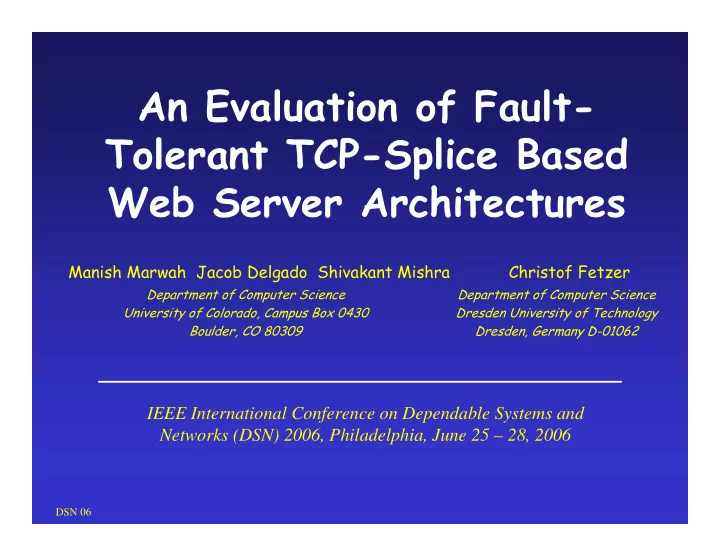

An Evaluation of Fault- Tolerant TCP-Splice Based Web Server Architectures Manish Marwah Jacob Delgado Shivakant Mishra Christof Fetzer Department of Computer Science Department of Computer Science University of Colorado, Campus Box 0430 Dresden University of Technology Boulder, CO 80309 Dresden, Germany D-01062 IEEE International Conference on Dependable Systems and Networks (DSN) 2006, Philadelphia, June 25 – 28, 2006 DSN 06
Outline • Introduction • Enhancements to TCP Splice • Our Web Server Architecture • Simulation Results • Conclusions DSN 06 2
Web Proxies • Proxies used for Video Servers – Content aware (layer 7) routing – Security policies S – Caching S – Network management S – Usage accounting C P P S • Drawbacks S – performance issues Backup C • kernel <-> user data copying S • Context switches S – Single point of failure S • Even with a backup, connection is broken and would need to be re-established Audio Servers DSN 06 3
TCP Splice (1) • Introduced to enhance the performance of web proxies • Proxy relays data between client and server by manipulating TCP segment headers • Advantages – Done entirely in the kernel – Latency and computational cost at proxy only a few times more than IP forwarding – End-to-end semantics of the client-server TCP connection preserved – No buffering at the proxy DSN 06 4
TCP Splice (2) DSN 06 5
TCP Splice (3) send_seq_num = (recv_seq_num – init_recv_seq_num) + init_send_seq_num offset DSN 06 6
Enhancements to TCP Splice • Recently, we proposed the following generic enhancements to TCP splice to address S C LB – Fault tolerance – Scalability • Replicated and Parallel Splice – Same connection can be spliced Proxies through different machines One TCP connection • Split-Splice – Traffic in the two different directions of the same connection can be spliced at different LB S C machines Proxies DSN 06 7
Our Web Server Architecture Logical View DSN 06 8
Load Balancer • IP level load balancer (LB) • No modifications to the packets • No connection state information is kept • Completely stateless -> fault tolerance trivial • Has service IP address • Right now round-robin algorithm • Heartbeat mechanism between LB and proxies – For failure detection – For communicating proxy workload (in future) • Can be combined with router or proxies DSN 06 9
Sequence of Steps involved in Handling a Request DSN 06 10
Web Server Configuration 1 (1) • Separate Proxy and backend server machines • Traffic in both directions passes through the proxies • No OS changes required on the backend servers DSN 06 11
Web Server Configuration 1 (2) One TCP connection Data Path DSN 06 12
Web Server Configuration 2 (1) • Co-located Proxy and backend server machines • Separate proxy machines not required • Saves HW • OS changes required on the servers DSN 06 13
Web Server Configuration 2 (2) One TCP connection Data Path DSN 06 14
Web Server Configuration 3 (1) • Mixed configuration: OS changes are required on some machines • Backend servers where OS can be changed do split-splice DSN 06 15
Web Server Configuration 3 (2) Two TCP connections Data Path DSN 06 16
Simulations • A discrete event simulator was written to simulate the architectures • Goal of the simulations is to show scalability • Connections simulated are assumed to be already established and spliced • Some simulation parameters – Splicing Cost: 25 µ sec – Client – Proxy link delay: 25 ms – Proxy – Server link delay: 0.7 ms – TCP buffer: 256kB – Packet size: 1460 B – Q processing Rate: 1 Gbps DSN 06 17
Separate proxy and back-end server (1) (Web Server Configuration 1) • Goal: show scalability of architecture • Client – data is generated from 30 Mbps to 990 Mbps in intervals of 60 Mbps – 50 MB is transferred at each data rate • Proxies – Varied from 1 to 13 • 1 Backend server used DSN 06 18
Separate proxy and back-end server (2) DSN 06 19
Separate proxy and back-end server (3) DSN 06 20
Co-located proxy and back-end server (Web Server Configuration 2) • The same experiments were repeated for this scenario • Proxy – Backend server link delay was made zero • Almost identical to separate proxy and backend server scenario since link delay was already small DSN 06 21
Split Splice (1) • Same experiments were repeated for split splice • Data generated at a backend server, spliced and sent directly to client DSN 06 22
Split-Splice (2) Splicing cost: 25 µ sec Splicing cost: 2 µ sec DSN 06 23
Conclusions and Future Work • Presented web server architectures based on enhanced TCP splice • Used simulations to evaluate these architectures • In particular, simulated three different configurations – Scale well – Connections preserved even on proxy failure – Proxy not a bottleneck • Linux prototype implementation paper to be presented at SRDS ‘06 • In future, make architecture tolerate backend server failures while preserving client connection DSN 06 24
Backup Slides DSN 06 25
Proxies • Perform TCP splicing • Before a connection is spliced, all packets of a particular connection are received by the same proxy through use of hashing and multicast groups (details in SRDS ’06 paper) • Proxy establishing splice distributes splicing state info to other proxies • Once a connection is spliced, a packet of that connection can be spliced at any proxy DSN 06 26
Recommend
More recommend